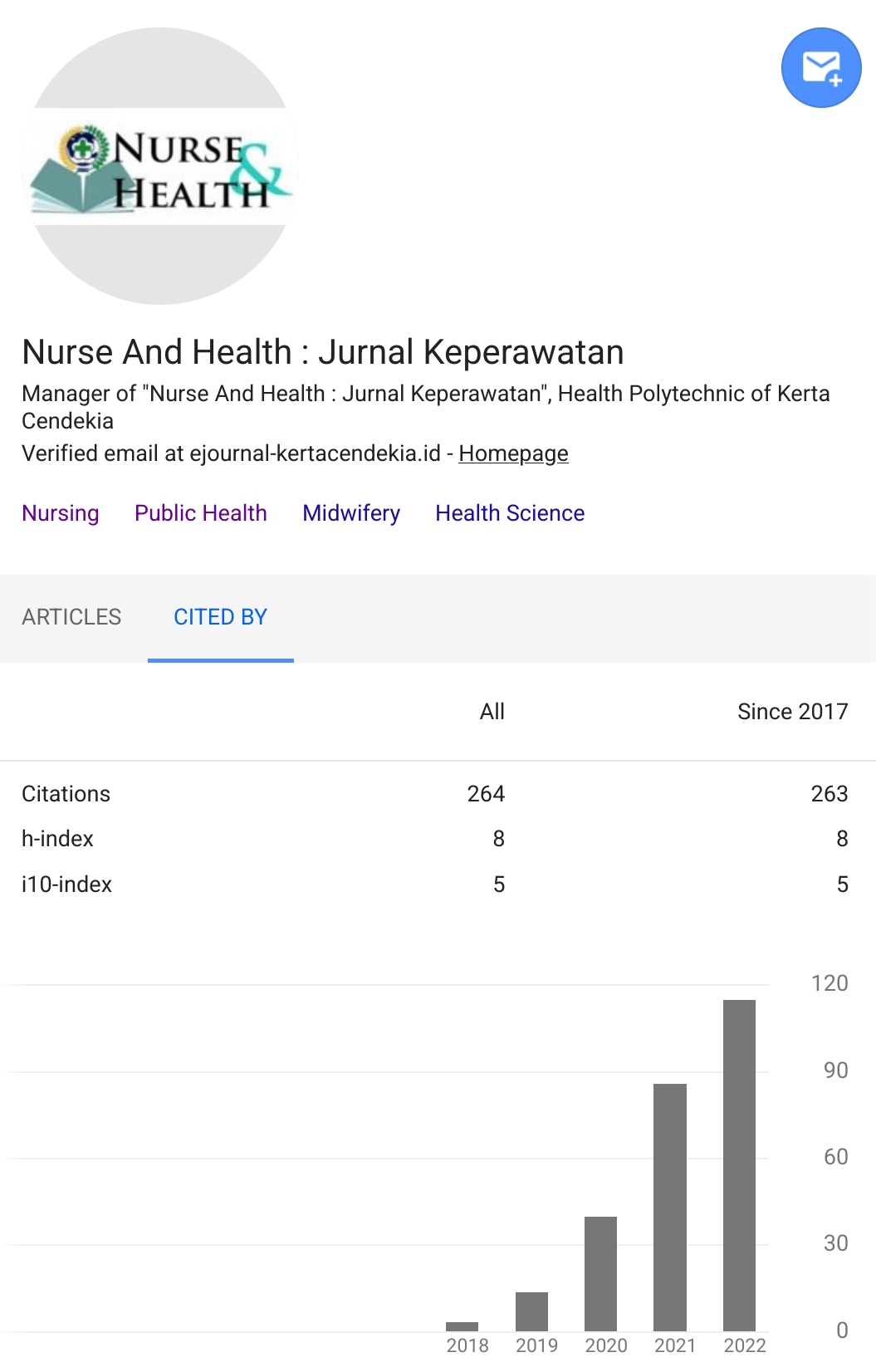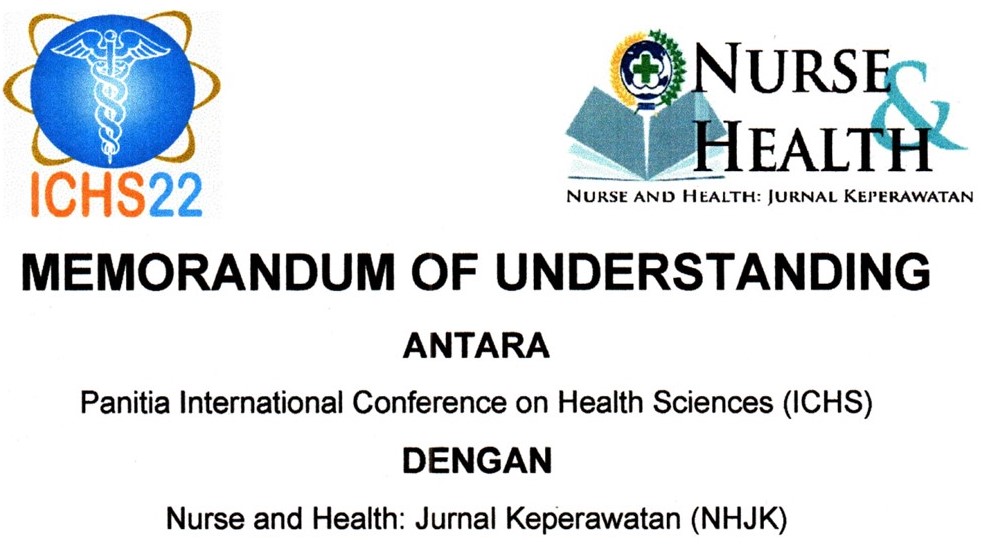DESCRIPTION OF POST TRAUMATIC STRESS DISORDER (PTSD) POST MOUNTAIN SEMERU ERUPTION
Abstract
Background: The existence of the eruption of Mount Semeru certainly has a considerable impact on aspects of life, both in physical, social, psychological aspects, and has the potential to experience Post Traumatic Traumatic Stress Disorder (PTSD). Traumatic experiences can cause various disorders including physical, psychological and social development disorders which will have an impact on mental, emotional, social and personality disorders as well as disturbances in self-esteem. Objectives: To describe the PTSD in victims of natural disasters after the eruption of Mount Semeru. Methods: This study used a descriptive research design with a survey approach to respondents, with a total of 65 respondents. The sample used in this study was 65 respondents aged around 17 to > 65 years and over divided into the intervention group and the control group. This research was conducted in the Lumajang Regency Recolation area, using an instrument in the form of PCL-C from May to June 2023. Results: The results showed that the majority of respondents did not indicate symptoms of Post Traumatic Stress Disorder (PTSD) as many as 12 people (18.5%) and most of them indicated symptoms of Post Traumatic Stress Disorder (PTSD) from mild to severe severity as many as 53 people (81.5%). Most of them were aged between 17-45 years as many as 51 people (78.4%) and a small portion aged 46-65 years &> 65 years as many as 14 people (21.6%). Conclusion: The results of this study are expected to be used as a reference in the development of nursing interventions as an effort to reduce the symptoms experienced by PTSD sufferersDownloads
References
Arrahim, D. D. W., Ginanjar, R., & Listyandini, R. (2021). Dominant Aspects Cause Work Stress in Inpatient Nurses at Bogor Islamic Hospital in 2020. Promotor, 4(2), 88–96. https://doi.org/10.32832/pro.v4i2.5575 DOI: https://doi.org/10.32832/pro.v4i2.5575
Damayanti, M., & Sofyan, O. (2022). The Relationship between Education Level and the Knowledge Level of the Community in Sumberan Sedayu Hamlet, Bantul About the Prevention of Covid-19 in January 2021. Pharmaceutical Magazine, 18(2), 220–226. https://doi.org/10.22146/farmaseutik.v18i2.70171 DOI: https://doi.org/10.22146/farmaseutik.v18i2.70171
Erlin, F., & Sari, I. Y. (2020). Gejala PTSD (Post Traumatic Stress Disorder) The Effects of a Flood Disaster on the Communities of Meranti Rumba Pesisir Village, Pekanbaru. Indonesian Environmental Dynamics, 7(1), 17. https://doi.org/10.31258/dli.7.1.p.17-21 DOI: https://doi.org/10.31258/dli.7.1.p.17-21
Ernawati, D., Mustikasari, & Panjaitan, R. U. (2020). Description of Post Traumatic Stress Disorder in Natural Disaster Victims of Post Merapi Eruption for a Decade. Journal of Psychiatric Nursing, 03(02), 101–112.
Faturahman, B. M. (2019). Disaster Mitigation Conceptualization Through Public Policy Perspective. Progress in Retinal and Eye Research, 561(3), S2–S3.
Hanifah, U. N., & Pratiwi, A. (2020). An overview of the anxiety of children with post traumatic stress disorder as a result of the tornado natural disaster. Journal of Psychiatric Nursing, 3(2), 173–184. https://core.ac.uk/download/pdf/327188763.pdf
Indonesia, U. R. (2007). LAW OF THE REPUBLIC OF INDONESIA NUMBER 24 OF 2007. In Disaster: Vol. вы12у (Issue 235). http://digilib.unila.ac.id/4949/15/BAB II.pdf
Kading, A. R., Tungka, A. E., & Sembel, A. S. (2021). Analysis of the Lokon Volcano Disaster Risk Level in Tomohon. Matrasain Media, 17(2), 50–63. https://ejournal.unsrat.ac.id/index.php/jmm/article/view/37039
Kousky, C. (2016). Impacts of natural disasters on children. Future of Children, 26(1), 73–92. https://doi.org/10.1353/foc.2016.0004 DOI: https://doi.org/10.1353/foc.2016.0004
Krantz, D. S., Shank, L. M., & Goodie, J. L. (2022). Post-Traumatic Stress Disorder (PTSD) as a Systemic Disorder: Pathways to Cardiovascular Disease. Health Psychology, 41(10), 651–662. https://doi.org/10.1037/hea0001127 DOI: https://doi.org/10.1037/hea0001127
Nugroho, A. (2018). Development Of A Mountain Eruption Mitigation Learning Model At Mountain Slamet Elementary School. Journal of Multidisciplinary Community Service, 1(2), 1–23.
Orui, M., Sato, Y., Tazaki, K., Kawamura, I., Harada, S., & Hayashi, M. (2015). Delayed increase in male suicide rates in tsunami disaster- stricken areas following the great east Japan earthquake: A three-year follow-up study in Miyagi prefecture. Tohoku Journal of Experimental Medicine, 235(3), 215–222. https://doi.org/10.1620/tjem.235.215 DOI: https://doi.org/10.1620/tjem.235.215
Parwanto, N. B., & Oyama, T. (2014). A statistical analysis and comparison of historical earthquake and tsunami disasters in Japan and Indonesia. International Journal of Disaster Risk Reduction, 7(November), 122–141. https://doi.org/10.1016/j.ijdrr.2013.10.003 DOI: https://doi.org/10.1016/j.ijdrr.2013.10.003
Rachma, H., & Febrianti, T. (2021). Social Determinant Factors of Post Traumatic Stress Disorder (PTSD) Risk after the Sunda Strait Tsunami Disaster. Health Journal, 12(2), 280. https://doi.org/10.26630/jk.v12i2.2148 DOI: https://doi.org/10.26630/jk.v12i2.2148
Reza Imaduddin, R. M. (2019). Post Traumatic Stress Disorder in Disaster Victims Post Traumatic Stress Disorder in Disaster Victims. Stress Disorder in Disaster Victims, 10(2), 178–182. https://doi.org/10.35816/jiskh.v10i2.141
Rizkya, I., Purwono, R. U., & Abidin, Z. (2020). The Effectiveness of Person-Centered Art Therapy to Reduce Symptoms of Post-Traumatic Stress Disorder (Ptsd) in Earthquake Survivors in Lombok. Journal of Psychological Science and Profession, 4(2), 106. https://doi.org/10.24198/jpsp.v4i2.24930 DOI: https://doi.org/10.24198/jpsp.v4i2.24930
Rubiono, G., Sari, N. N. I., & Cahyono, E. (2022). Higher Education Participation in Concern for the Mount Semeru Eruption Disaster in 2021. JATI EMAS (Journal of Engineering Applications and Community Service), 6(1), 19. https://doi.org/10.36339/je.v6i1.562 DOI: https://doi.org/10.36339/je.v6i1.562
Setiawan, L., Ratnawati, R., & Lestari, R. (2017). Phenomenological Study: Farmer Resilience Experience After the 2014 Mount Kelud Eruption in Puncu Village, Puncu District, Kediri Regency. NurseLine Journal, 2(2). DOI: https://doi.org/10.19184/nlj.v2i2.5926
Siregar, J. S., & Wibowo, A. (2019). Disaster Risk Reduction Efforts in Vulnerable Groups. Journal of Disaster Management Dialogue, 10(1), 30–38.
Wijayaningsih, K. S. (2014). Nursing Psychology.
Copyright (c) 2025 Primasari Mahardhika Rahmawati, Rondhianto, Suhari, Dwi Ochta Pebriyanti, R. Endro Sulistyono

This work is licensed under a Creative Commons Attribution-NonCommercial 4.0 International License.
Authors who publish with Nurse and Health: Jurnal Keperawatan agree to the following terms:
- Authors retain copyright licensed under a Creative Commons Attribution-NonCommercial 4.0 (CC BY-NC 4.0), which allows others to remix, tweak, and build upon the authors' work non-commercially, and although the others' new works must also acknowledge the authors and be non-commercial, they don't have to license their derivative works on the same terms.
- Authors are permitted and encouraged to post their work online (e.g., in institutional repositories or on their website) prior to and during the submission process, as it can lead to productive exchanges, as well as earlier and greater citation of published work (See The Effect of Open Access). Authors can archive pre-print and post-print or publisher's version/PDF.






















